Japan’s inflation revolution
.png)
Japan’s first real inflation in over 30 years is causing a revolution across the economy. Wage hikes may be the new norm, with companies taking a cue from central bankers and announcing forward guidance for wages.
The weak yen, which was a major driver of inflation, is fueling a tourist boom. Meanwhile, the global semiconductor shortage has moved from being another factor in higher prices to triggering a foreign investment-led renaissance in Japan’s tech sector. Capital spending could hit a new record.
Behind the scenes, the Bank of Japan remains supportive. While it tweaked the yield curve control policy recently, it seems unlikely to engage in true tightening that would constrain the economic boom that’s underway.
Nominal GDP for fiscal 2023 is expected to grow by 4 percent, according to a Nikkei survey – the most in 32 years. Meanwhile, the IMF forecasts that real GDP will grow at the third-fastest pace in the G7, as the next chart shows.
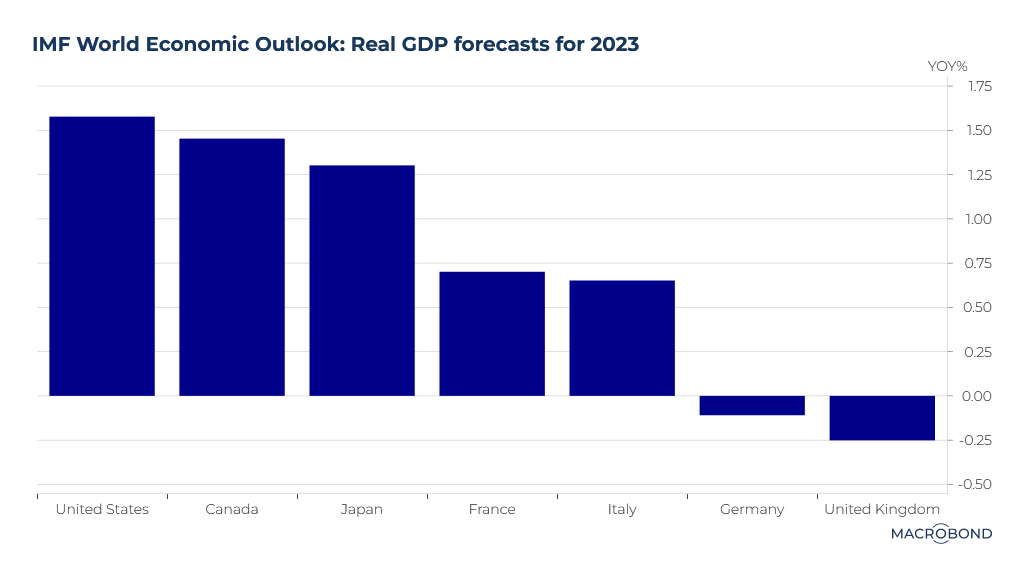
Then there’s the output gap, which is closely watched by policymakers. It’s the difference between actual GDP and potential GDP.
Thanks to the boom, Japan’s output gap is about to move from negative to positive – i.e., from being deflationary to inflationary.
One factor is the boom in tourism. Originally driven by the cheap yen, department stores say this trend has entered a second phase, thanks to an influx of Chinese tourists1.
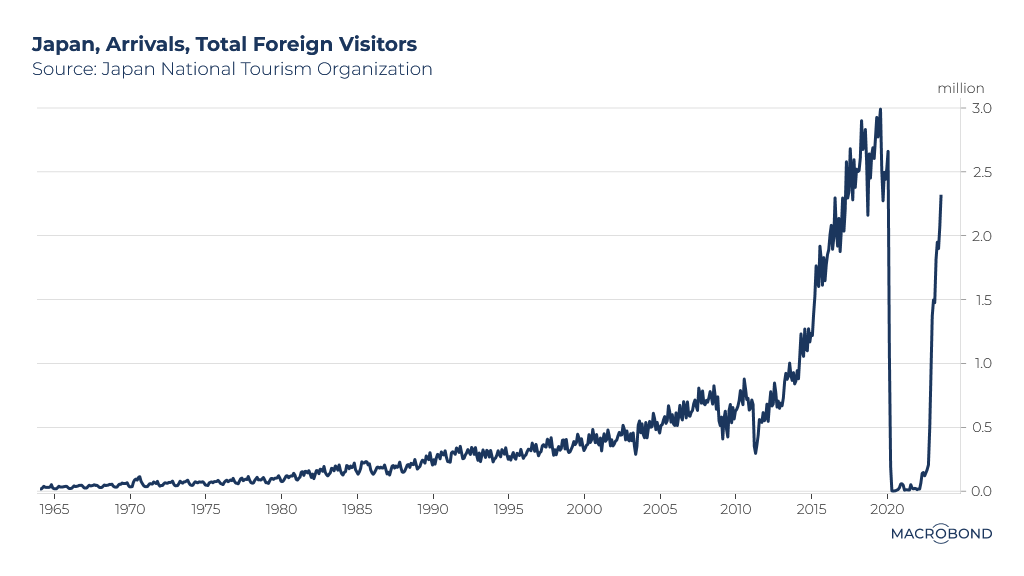
Consumer confidence has improved for five consecutive months. Indeed, the Cabinet Office used the word “improvement” in this context for the first time in nearly ten years.
Breaking a 30-year trend
Interestingly, the trigger for the boom was inflation. Excluding the effects of subsidies, inflation has reached 40-year highs, surpassing 4 percent. (For most of Japan’s post-bubble period, it hovered between zero and 1 percent, leaving consumer prices almost totally stable for 30 years, as the next chart shows.)
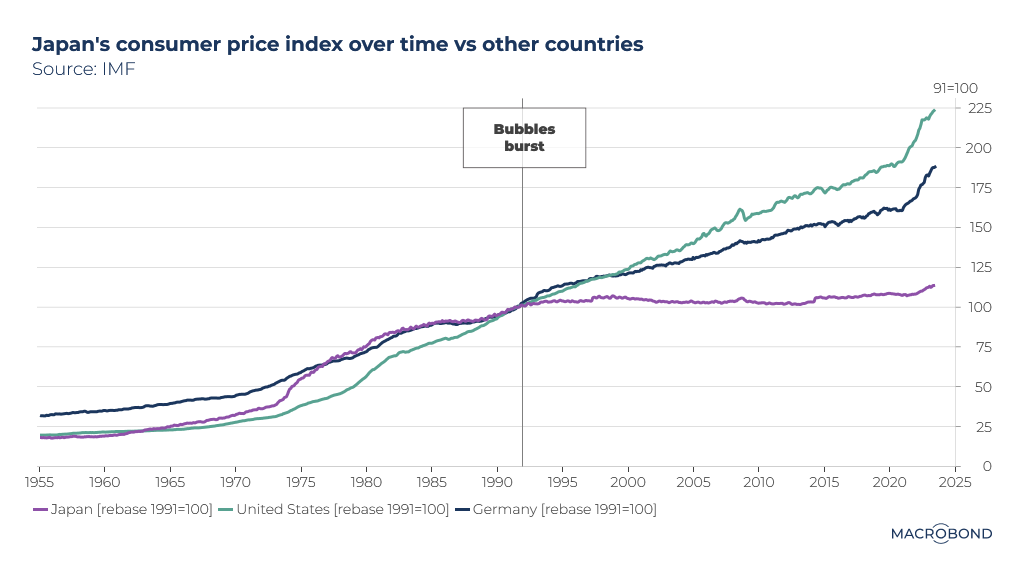
What is responsible for this sea change? The Bank of Japan’s monetary policy played a key role.
Inflation was exacerbated by the weak yen, which depreciated due to the widening interest rate differential with the US. As the US hiked policy rates by over 5 percent, Japan stayed put.
A weak yen boosts import prices – and Japan imports about 80 percent of its energy and 70 percent of its calories. Unsurprisingly, food and energy drove the inflationary trend, as the next graph shows.
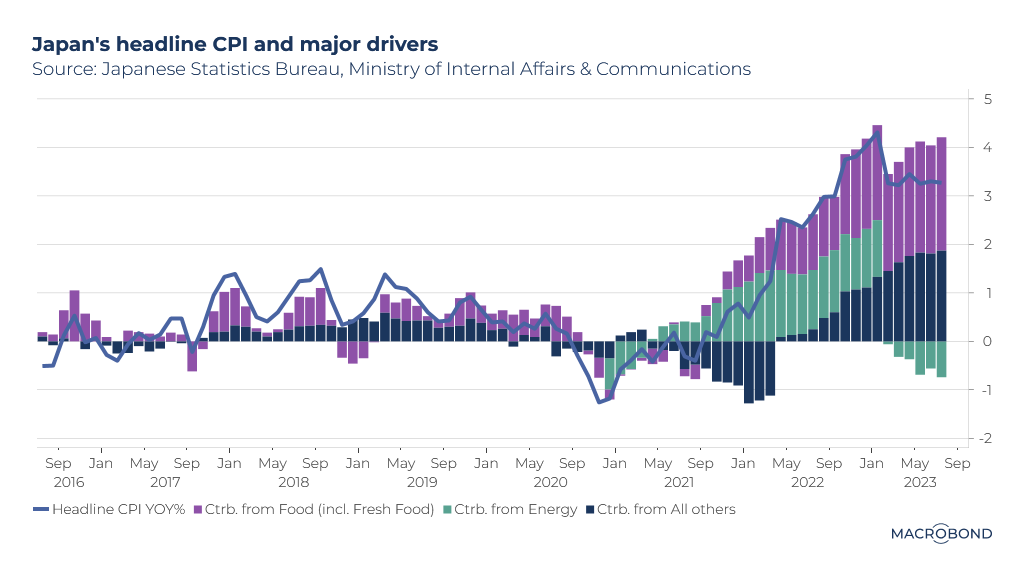
Wages at a time of extreme labour shortages
The inflation also sparked wage hikes –welcomed by the Kishida administration, which wants household incomes to rise as a top political priority.
According to Rengo, which represents 5,000 unions across multiple industries, workers recently won their highest wage hikes in 30 years2. And, surprisingly, public- and private-sector officials both say such wage hikes may be becoming the norm.
Besides keeping up with inflation, the wage gains are partially due to the extreme shortage of workers. Japan’s labour market tightness for prime-aged workers (25 to 54 years old) is the most extreme among major nations, according to OECD data visualised in the next chart.
Major construction companies are now turning down short-term projects, unable to find enough workers. And most interestingly, that “forward guidance” on wages is manifesting itself, with companies specifying the trajectory of employee pay for prospective workers: one firm promsed 4 percent increases per year through 20273.
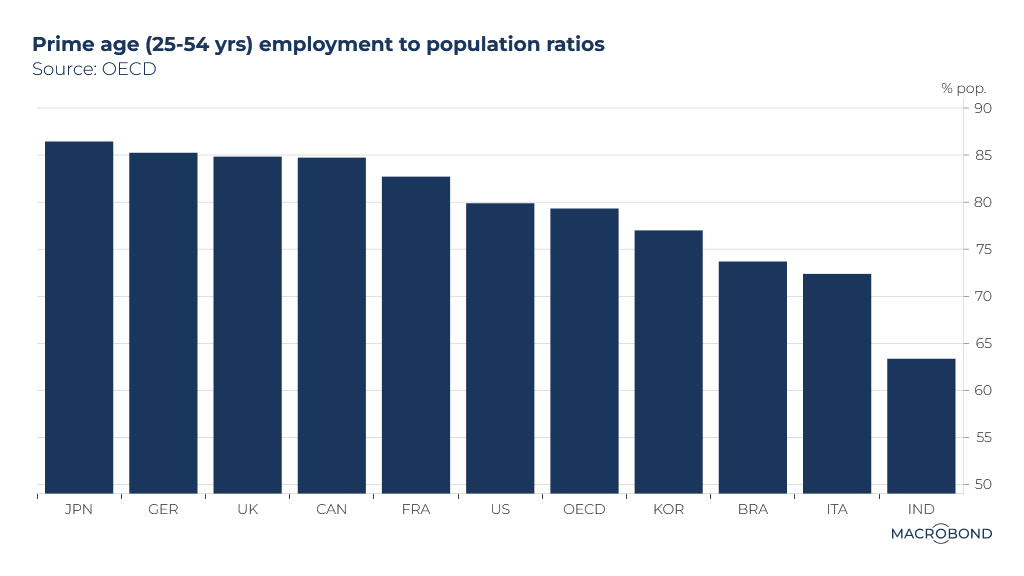%20employment%20to%20population%20ratios.png)
For now, the pay gains are trailing inflation, meaning real wage growth is negative. But thanks to massive energy subsidies and more stable trading for the yen, inflation has slowed. And if wage hikes continue, real wage growth could turn positive.
As the next chart shows, import prices are rapidly slowing and are expected to drag overall inflation down. Food prices, the main driver of inflation in Japan, are now expected to slow, according to Teikoku databank’s food manufacturer price surveys4.

The BOJ’s latest tweak
Late last month, the BOJ announced another tweak to its yield curve control policy, which manages trading on 10-year government bonds. The central bank will now allow yields to temporarily rise as high as 1 percent, while maintaining the target range of plus or minus 0.5 percent – and an official target of about zero.
Although the BOJ claims this isn’t a move toward normalisation (i.e., lift-off from negative short rates), the market sees the new effective yield ceiling at 1 percent instead of the quasi-official 0.5 percent. This should tighten the interest-rate differential with the US and prevent the yen from over-weakening, helping slow imported inflation.
This increased flexibility also hopes to make monetary easing more sustainable, while limiting government bond purchases. The BOJ has acknowledged that its inflation target of 2 percent, in a “sustainable and stable manner, supported by wages,” is closer to being achieved.
Corporate Japan changes its approach
Inflation woke up corporate Japan, too. The government has taken extraordinary measures to help companies of all sizes hike wages.
For instance, March and September are now called “cost pass-through months.” Smaller companies are encouraged to pass on higher costs to their larger clients and to report any unfair negotiations.
To pay for their wage hikes, companies must boost profitability. Price hikes, long shunned by companies afraid of losing market share in a deflationary environment, are now widely accepted – as the corporate Tankan survey charted in the next visualisation shows.
.png)
Other moves by Japan’s largest companies are playing a major role. For instance, new criteria for the nation’s key equity index are encouraging companies to raise their price-to-book ratios and return on equity. The result? Along with increased dividends and stock buybacks, capital expenditure is rising, and this is expected to continue.
According to Nikkei news, nominal capex is on the way to pass JPY 100 trillion, setting a new record.
.png)
TSMC, Samsung and Intel drive a tech resurgence
Semiconductors are so important for global industry that some observers call them the “new oil.” Their importance was seen when the pandemic disrupted supply, leading to knock-on effects like halts to automobile production lines – and, of course, global inflation.
Japan dominated semiconductors and the tech scene in the 1970s and 80s. But that golden age was ended by the Plaza Accord of 1985, the US-Japan Semiconductor Agreement of 1986, and the advent of the digital age from the 1990s onward. The loss of tech leadership coincided with Japan’s “lost decades.”
Now, Japan is attracting domestic and foreign investment to cement its role in global semiconductor supply chains. Examples include investments by Taiwan’s TSMC in Kumamoto, South Korea’s Samsung in Yokohama, America’s Intel in Toyama and Micron in Hiroshima, and Belgium’s Imec in Hokkaido. Notable domestic investments include Renesas in Kofu, Kyocera in Kagoshima, and Nidec in Kawasaki.
In conclusion, the inflation revolution is showing up in hard data, with nominal GDP approaching the Abenomics-era target of JPY 600 trillion. On the corporate side, fiscal 2022 revenue for major corporates improved by 11 percent, the fastest growth in over 30 years. And foreign investments are driving a restoration of Japan’s tech sector – even before developments in artificial intelligence that some observers say could nearly triple economic growth.5
Corporate Japan and government policymakers will be hoping to extend this boom.

1 Japan’s restaurants are one attraction, with Tokyo having more Michelin-starred restaurants than any other city as of 2022 (Source: Statista.com and CNBC)
2 Read more in my post: As Ueda takes the helm of the Bank of Japan, do record wage hikes finally portend “good inflation?”
3 Read more in my post: Forward wage guidance on... wages? Japan’s companies promise higher pay and consider AI – as stocks and GDP forecasts perk up
4 In Japanese: (VIEW LINK)
5 In 2017, a report from the Ministry of Internal Affairs implied that average real GDP growth through 2030 would accelerate, up from 0.9 percent to a 2.4 percent yearly pace. Read more: Forward wage guidance on... wages? Japan’s companies promise higher pay and consider AI – as stocks and GDP forecasts perk up
Related posts from this author:
Why US inflation will slow and help the BOJ
As Ueda takes the helm of the Bank of Japan, do record wage hikes finally portend “good inflation?”
5 topics
.png)
Macrobond delivers the world’s most extensive macroeconomic & financial data alongside the tools and technologies to quickly analyse, visualise and share insights – from a single integrated platform. Our application is a single source of truth for...
Expertise
.png)
Macrobond delivers the world’s most extensive macroeconomic & financial data alongside the tools and technologies to quickly analyse, visualise and share insights – from a single integrated platform. Our application is a single source of truth for...
.png)